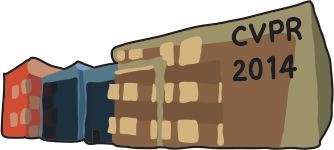-
A Mixture of Manhattan Frames: Beyond the Manhattan World
AbstractObjects and structures within man-made environments typically exhibit a high degree of organization in the form of orthogonal and parallel planes. Traditional approaches to scene representation exploit this phenomenon via the somewhat restrictive assumption that every plane is perpendicular to one of the axes of a single coordinate system. Known as the Manhattan-World model, this assumption is widely used in computer vision and robotics. The complexity of many real-world scenes, however, necessitates a more flexible model. We propose a novel probabilistic model that describes the world as a mixture of Manhattan frames: each frame defines a different orthogonal coordinate system. This results in a more expressive model that still exploits the orthogonality constraints. We propose an adaptive Markov-Chain Monte-Carlo sampling algorithm with Metropolis-Hastings split/merge moves that utilizes the geometry of the unit sphere. We demonstrate the versatility of our Mixture-of-Manhattan-Frames model by describing complex scenes using depth images of indoor scenes as well as aerial-LiDAR measurements of an urban center. Additionally, we show that the model lends itself to focal-length calibration of depth cameras and to plane segmentation.
Related Material
[pdf][bibtex]@InProceedings{Straub_2014_CVPR,
author = {Straub, Julian and Rosman, Guy and Freifeld, Oren and Leonard, John J. and Fisher, III, John W.},
title = {A Mixture of Manhattan Frames: Beyond the Manhattan World},
booktitle = {Proceedings of the IEEE Conference on Computer Vision and Pattern Recognition (CVPR)},
month = {June},
year = {2014}
}
These CVPR 2014 papers are the Open Access versions, provided by the Computer Vision Foundation.
Except for the watermark, they are identical to the accepted versions; the final published version of the proceedings is available on IEEE Xplore.
Except for the watermark, they are identical to the accepted versions; the final published version of the proceedings is available on IEEE Xplore.
This material is presented to ensure timely dissemination of scholarly and technical work.
Copyright and all rights therein are retained by authors or by other copyright holders.
All persons copying this information are expected to adhere to the terms and constraints invoked by each author's copyright.

